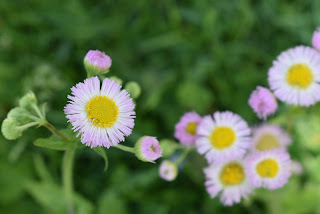 My lawn is growing so fast I can barely keep up. Everywhere I look I see a chore that needs to be done- the dead branch that needs pruning, the garden that needs weeding, and of course the lawn that needs mowing. This can be exhausting.
My lawn is growing so fast I can barely keep up. Everywhere I look I see a chore that needs to be done- the dead branch that needs pruning, the garden that needs weeding, and of course the lawn that needs mowing. This can be exhausting. The contemplative path calls us to a different way of looking at the world. Jesuit theologian Walter Burghardt described contemplation as taking a “long, loving look at the real”. Instead of seeing the world around us as a to do list, the contemplative path invites us to be present with what is, exactly as it is.
 So during this time of abundant growth, I have adopted a spiritual practice of gazing out from my front porch with a long, loving look at all I see. My practice is to just observe. I live right downtown, so what I see each day is the same few trees, my neighbors houses, some parked cars, and strips of lawn in varying states of growth. But the longer I look with that loving gaze, the more deeply I know this place. That dead branch shows me something about the hard winter the tree had, and I become curious about the patterns of which branches die and which live. The dead branches on a tree represent an important part of the cycle of life. In fact, scientists are leaning more every day about the important role death plays in the eco-system of which that tree is a part. If the branch poses no immanent risk to passers-by or power lines, I accept the challenge to gaze at it just as it is without leaping up to get the clippers. .
So during this time of abundant growth, I have adopted a spiritual practice of gazing out from my front porch with a long, loving look at all I see. My practice is to just observe. I live right downtown, so what I see each day is the same few trees, my neighbors houses, some parked cars, and strips of lawn in varying states of growth. But the longer I look with that loving gaze, the more deeply I know this place. That dead branch shows me something about the hard winter the tree had, and I become curious about the patterns of which branches die and which live. The dead branches on a tree represent an important part of the cycle of life. In fact, scientists are leaning more every day about the important role death plays in the eco-system of which that tree is a part. If the branch poses no immanent risk to passers-by or power lines, I accept the challenge to gaze at it just as it is without leaping up to get the clippers. . The same practice came in handy when I noticed myself looking with judgement at the lawn of my neighbor who never did mow. Day after day I watched the spring grass grow into an unruly
 lawn. My judgmental gaze softened, and I began to look at it not as a neglected action item, but just as the reality of the moment. Then the wildflowers appeared – I’d never seen daisies growing in the city before. Butterflies came. It became a little patch of meadow. Each day my gaze lingered I began to love it just as it was.
lawn. My judgmental gaze softened, and I began to look at it not as a neglected action item, but just as the reality of the moment. Then the wildflowers appeared – I’d never seen daisies growing in the city before. Butterflies came. It became a little patch of meadow. Each day my gaze lingered I began to love it just as it was. Sometimes this long, loving gaze does call me to action. As I write this, we have gone too long without rain, and the soil has become parched and dry in places. It is because of that long loving gaze that I learned what a thirsty plant looks like, and what a plant in danger looks like. But, you might say, every gardener knows that, every farmer knows that. Yes! That is why gardening is a spiritual practice for so many people- because gardeners watch with love and concern as each plant they tend grows and thrives or struggles. So it is with the nature lovers, hikers and bird watchers who take time to let their ears and eyes linger with a long loving attention to whatever is around them.
Even when leave our stillness to pick up a piece of trash, water a thirsty plant or rev up the mower, the work can still be done with a contemplative gaze. We can notice the muscles we use as we move into action, we can observe our thoughts and feelings as we do our work, we can notice the effect of our work on the world around us, and when the work is done, remember to take time to look lovingly, deeply at the ever changing world we are part of tending and transforming every day.
Nice! Deciding to be still to observe is a challenging spiritual practice in our culture.
ReplyDeleteNice! Deciding to be still to observe is a challenging spiritual practice in our culture.
ReplyDelete